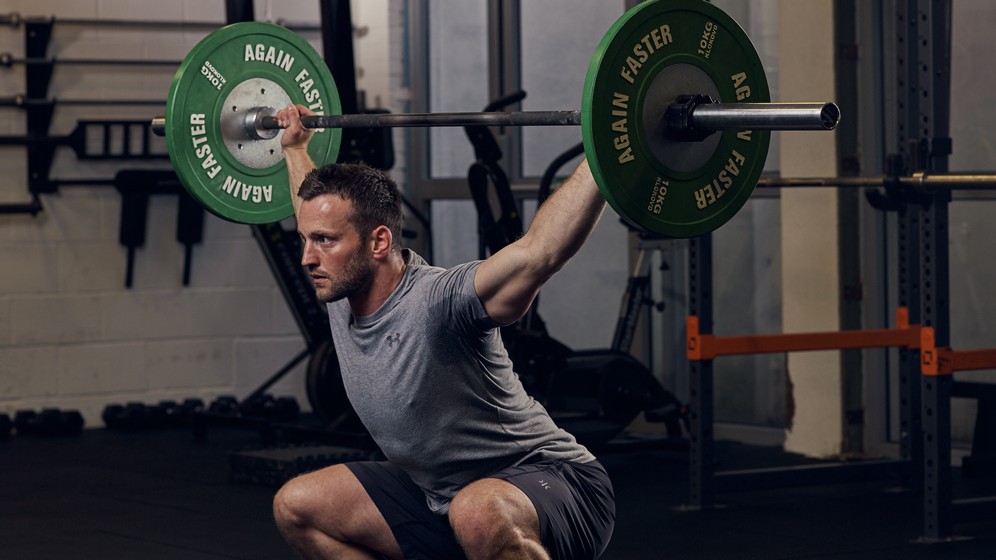How to Start Olympic Weightlifting Training
It’s a sport in itself, but you don’t need a singlet or gold-medal aspirations to benefit from increased power, mobility and speed

Photography Glen Burrows; model Tom Eastham
Olympic Weightlifting 101
What is it?
Training and competing in the two Olympic lifts: the snatch (where the bar goes from the floor to overhead in one move) and the clean and jerk (where you “clean” the bar to your shoulders, then push-press it overhead and drop underneath it). Competitive lifters get three attempts at each to post a combined total for both.
What’s it best for?
“Although I compete, I first learned the lifts for developing power for other sports,” says strength and conditioning coach Alex Adams. “It’s essentially jumping with weights, so it improves not only strength but speed and rate of force development.”
What are its limitations?
It’s not exactly entry-level. “To do the full lifts safely requires very good mobility, flexibility and balance,” says Adams. “This shouldn’t put people off – practising the positions is a great way to improve knee and hip flexibility.” But forget the cardio until you’re experienced. “Fatigue reduces rep quality, so Oly lifts aren’t great for metabolic work until you’ve learned your technical limits.”
The outside view
“Olympic lifting is very technical and to be good requires a lot of practice,” says powerlifter Tom Hamilton. “If you get bored easily, it isn’t for you. The benefits are clear though – it builds strong, powerful physiques, requires a good level of flexibility, gives you clear targets to work on and can be fun.”
Instant expertise
Learn the hook grip
Tuck your thumb under your first two fingers. It hurts but it works. “It secures the bar much better and leads to higher loads lifted in the long term,” says Adams. “Anyone who lifts should use it.” It’ll also help you improve your deadlift.
Know your power hangs
“The terminology is fairly simple: power variations are lifts caught in a half squat or higher,” says Adams. “Cleans and snatches can be done from the ‘hang’, meaning that you don’t start from the floor – but you could start anywhere from knee to mid-thigh, depending on what you’re working on.”
Get the Coach Newsletter
Sign up for workout ideas, training advice, reviews of the latest gear and more.
Don’t say “squat clean”
“That’s a CrossFit thing,” says Adams. “In reality, every full squat or clean should be caught at full squat depth – otherwise it’s an indication that you could be lifting more.”
You’ve made it when…
You can clean and jerk your own bodyweight. “That’s my initial benchmark, but you’re doing well if you can then progress to snatching bodyweight,” says Adams. Want to compete? Standards are high: to qualify for a English national competition you’d need to total 239kg as an 85kg lifter.
Build Power Session
“Most sessions will begin with snatch or a snatch variant,” says Adams. “It takes the most speed to execute so it comes when you’re freshest. I usually do both lifts on the same day but vary the exact exercise to limit the crossover and fatigue. Most sessions will have a heavy squat or pull but rarely both. Assistance work like pressing, rowing and back and abs comes last.”
1 Snatch pull
Sets 5 Reps 2
It’s easier than the full snatch, but still a great power generator. Set up with the bar on the floor and your hands fairly wide. Drive up, and bump the bar off your hips as you shrug it slightly upwards. Drop, reset and go again.
2 High hang clean
Sets 4 Reps 2
Start with the bar in your hands, with a shoulder-width grip. Bend your knees slightly, then do a small jump as you explosively bring the bar to your shoulders.
3 Front squat
Sets 4 Reps 3
Take the bar out of a rack with it resting across the front of your shoulders, supporting it slightly with your fingertips. Squat down with your weight on your heels, and drive back up.
4 Bent-over row
Sets 3 Reps 8
Bend forward at the hips, and pull the barbell to your sternum. Pause, then lower.
5 Hanging leg raise
Sets 3 Reps 10
Hang from a bar with your legs straight. Bring them until they’re at 90˚ from your torso, pause and lower.
From 2008 to 2018, Joel worked for Men's Fitness, which predated, and then shared a website with, Coach. Though he spent years running the hills of Bath, he’s since ditched his trainers for a succession of Converse high-tops, since they’re better suited to his love of pulling vans, lifting cars, and hefting logs in a succession of strongman competitions.










